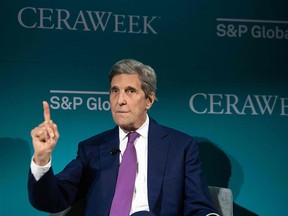The annual CERAWeek meeting is underway in Houston, promoted as the world’s “premier” annual climate and energy event where a parade of corporate and political heavyweights, such as U.S. climate czar John Kerry, spar over the future of the global energy system.
Economy
Terence Corcoran: Shattered windows and the broken economy fallacy
|
|
Smashing carbon energy will not bring a ‘just transition’ to better growth

A famous economic parable from the work of French economist Frederic Bastiat in 1850 outlines what is known in economic circles as the Broken Window Fallacy. In the parable, a boy smashes the window in a town shop, creating an expense and loss for the shopkeeper. But a bystander observes that there is an economic benefit to smashing windows: Glassmakers get more business, a conclusion glibly summarized in one commentary: “It’s a good thing to break windows — money gets circulated and the industry thrives.”
That’s the fallacy: Destructive acts of man or nature create economic opportunity that trumps the loss. Even acts of war have big payoffs. The Second World War has often been seen as the catalyst for American prosperity and a model for governments today. Why not use the same government interventions and policies to mobilize industry and the private sector to reshape the economy to fit some new pre-conceived idea of economic perfection. We don’t have a war, but we could act as if we had a war.
At CERAWeek, Kerry is reported to have dragged in the war-climate analogy, calling for a global mobilization to fight climate change. It was a milder replay of his claim earlier this year that the global effort to achieve net-zero carbon emissions was comparable to fighting the Nazis; it requires setting the global economy on a war footing.
Bastiat, in his summary of the original broken window parable, said his story “contains an entire theory … which, unhappily, regulates the greater part of our economical institutions.” That was 1850, but it’s even more true in 2023 as governments in the Western world attempt to smash the windows of the energy system and replace it with an all-new net-zero energy regime.
The broken window fallacy in such thinking, if I can presume to condense Bastiat, is that the real cost of breaking windows is ignored. The window repair company will make $2,000 from the repair costs and the new spending will be incorporated into GDP as a source of growth. Missing in that summary is the fact that the shop owner has lost $2,000 and has nothing to show for it. He has, moreover, lost the opportunity to buy $2,000 worth of clothing for his kids or to invest in a new lunch counter that would increase his shop’s sales and his income.
If window smashing advances the economy, why not break millions of windows and see their replacement as a source of growth — the production of glass, frames, manufacturing, distribution, installation? That, unfortunately, is exactly the plan now being proposed by the build-back-better proponents and the great net-zero energy resetters at the helm of Canada’s just transition plan and the industrial subsidy regime now being installed in the United States.
Theorists such as Mark Carney see the push to carbon net-zero, through the massive reduction in fossil-fuel use, as a golden growth opportunity. “If you are making investments, coming up with new technologies, changing the way you do business, all in service of reducing and eliminating that threat, you are creating value.”
When Ottawa recently outlined its “just transition” action plan to achieve net-zero by 2050 the overriding message could have been taken from Bastiat’s parable. Governments, workers and industry need to join together to harness the opportunity of a net-zero low-carbon energy future that “represents a generational economic opportunity for every region of this country — a shift that will secure the future of our energy sector and create more good jobs for Canadians.”
As critics have noted, the planning document is a waffling load of bureaucratese. It also neatly changes the slogan of the plan from the “Just Transition” plan to the “Sustainable Jobs” plan, likely in recognition that the “just transition” slogan has its 1970s roots in the U.S. labour movement and has been enthusiastically endorsed by the socialist left and radical environmental groups.
The fallacy also looms large in consultancy and financial institution reports that see the great transition away from carbon emissions as a grand $2-trillion opportunity. But the cost of breaking all those fossil fuel windows are rarely mentioned, let alone systematically calculated.
Some observers, though, have attempted to measure costs. In a paper last year for the Public Policy Forum, British Columbia analyst Don Wright asked: “Do We Really Want to Make Canadians Poorer? What Shutting Down Its Oil and Gas Sector Would Cost Canada.” Wright’s effort to nail the costs of decarbonization turns up some big numbers. Shutting down oil and gas production would cut GDP by six per cent, for example.
But that’s just a rough start on exposing the broken economy fallacy behind the energy decarbonization transition plans under discussion at CERAWeek in Houston. Much more needs to be done before they start deliberately smashing all our energy windows.





Economy
Poland has EU's second highest emissions in relation to size of economy – Notes From Poland
[unable to retrieve full-text content]
Poland has EU’s second highest emissions in relation to size of economy Notes From Poland





Source link
Economy
IMF's Georgieva warns "there's plenty to worry about'' in world economy — including inflation, debt – Yahoo Canada Finance

WASHINGTON (AP) — The head of the International Monetary Fund said Thursday that the world economy has proven surprisingly resilient in the face of higher interest rates and the shock of war in Ukraine and Gaza, but “there is plenty to worry about,” including stubborn inflation and rising levels of government debt.
“ Inflation is down but not gone,” Kristalina Georgieva told reporters at the spring meeting of the IMF and its sister organization, the World Bank. In the United States, she said, “the flipside” of unexpectedly strong economic growth is that it ”taking longer than expected” to bring inflation down.
Georgieva also warned that government debts are growing around the world. Last year, they ticked up to 93% of global economic output — up from 84% in 2019 before the response to the COVID-19 pandemic pushed governments to spend more to provide healthcare and economic assistance. She urged countries to more efficiently collect taxes and spend public money. “In a world where the crises keep coming, countries must urgently build fiscal resilience to be prepared for the next shock,” she said.
On Tuesday, the IMF said it expects to the global economy to grow 3.2% this year, a modest upgrade from the forecast it made in January and unchanged from 2023. It also expects a third straight year of 3.2% growth in 2025.
ADVERTISEMENT
The world economy has proven unexpectedly sturdy, but it remains weak by historical standards: Global growth averaged 3.8% from 2000 to 2019.
One reason for sluggish global growth, Georgieva said, is disappointing improvement in productivity. She said that countries had not found ways to most efficiently match workers and technology and that years of low interest rates — that only ended after inflation picked up in 2021 — had allowed “firms that were not competitive to stay afloat.”
She also cited in many countries an aging “labor force that doesn’t bring the dynamism” needed for faster economic growth.
The United States has been an exception to the weak productivity gains over the past year. Compared to Europe, Georgieva said, America makes it easier for businesses to bring innovations to the marketplace and has lower energy costs.
She said countries could help their economies by slashing bureaucratic red tape and getting more women into the job market.
Paul Wiseman, The Associated Press
Economy
Nigeria’s Economy, Once Africa’s Biggest, Slips to Fourth Place – BNN Bloomberg


(Bloomberg) — Nigeria’s economy, which ranked as Africa’s largest in 2022, is set to slip to fourth place this year and Egypt, which held the top position in 2023, is projected to fall to second behind South Africa after a series of currency devaluations, International Monetary Fund forecasts show.
The IMF’s World Economic Outlook estimates Nigeria’s gross domestic product at $253 billion based on current prices this year, lagging energy-rich Algeria at $267 billion, Egypt at $348 billion and South Africa at $373 billion.
Africa’s most industrialized nation will remain the continent’s largest economy until Egypt reclaims the mantle in 2027, while Nigeria is expected to remain in fourth place for years to come, the data released this week shows.
Nigeria and Egypt’s fortunes have dimmed as they deal with high inflation and a plunge in their currencies.
Bola Tinubu has announced significant policy reforms since he became Nigeria’s president at the end of May 2023, including allowing the currency to float more freely, scrapping costly energy and gasoline subsidies and taking steps to address dollar shortages. Despite a recent rebound, the naira is still 50% weaker against the greenback than what it was prior to him taking office after two currency devaluations.
Read More: Why Nigeria’s Currency Rebounded and What It Means: QuickTake
Egypt, one of the emerging world’s most-indebted countries and the IMF’s second-biggest borrower after Argentina, has also allowed its currency to float, triggering an almost 40% plunge in the pound’s value against the dollar last month to attract investment.
The IMF had been calling for a flexible currency regime for many months and the multilateral lender rewarded Egypt’s government by almost tripling the size of a loan program first approved in 2022 to $8 billion. This was a catalyst for a further influx of around $14 billion in financial support from the European Union and the World Bank.
Read More: Egypt Avoided an Economic Meltdown. What Next?: QuickTake
Unlike Nigeria’s naira and Egypt’s pound, the value of South Africa’s rand has long been set in the financial markets and it has lost about 4% of its value against the dollar this year. Its economy is expected to benefit from improvements to its energy supply and plans to tackle logistic bottlenecks.
Algeria, an OPEC+ member has been benefiting from high oil and gas prices caused first by Russia’s invasion of Ukraine and now tensions in the Middle East. It stepped in to ease some of Europe’s gas woes after Russia curtailed supplies amid its war in Ukraine.
©2024 Bloomberg L.P.
-



 Tech23 hours ago
Tech23 hours agoCytiva Showcases Single-Use Mixing System at INTERPHEX 2024 – BioPharm International
-



 Science5 hours ago
Science5 hours agoJeremy Hansen – The Canadian Encyclopedia
-



 Health19 hours ago
Health19 hours agoSupervised consumption sites urgently needed, says study – Sudbury.com
-
News19 hours ago
Canada's 2024 budget announces 'halal mortgages'. Here's what to know – National Post
-
News18 hours ago
2024 federal budget's key takeaways: Housing and carbon rebates, students and sin taxes – CBC News
-



 Investment5 hours ago
Investment5 hours agoUK Mulls New Curbs on Outbound Investment Over Security Risks – BNN Bloomberg
-



 Tech21 hours ago
Tech21 hours agoNew EV features for Google Maps have arrived. Here’s how to use them. – The Washington Post
-



 Science18 hours ago
Science18 hours agoGiant, 82-foot lizard fish discovered on UK beach could be largest marine reptile ever found – Livescience.com




